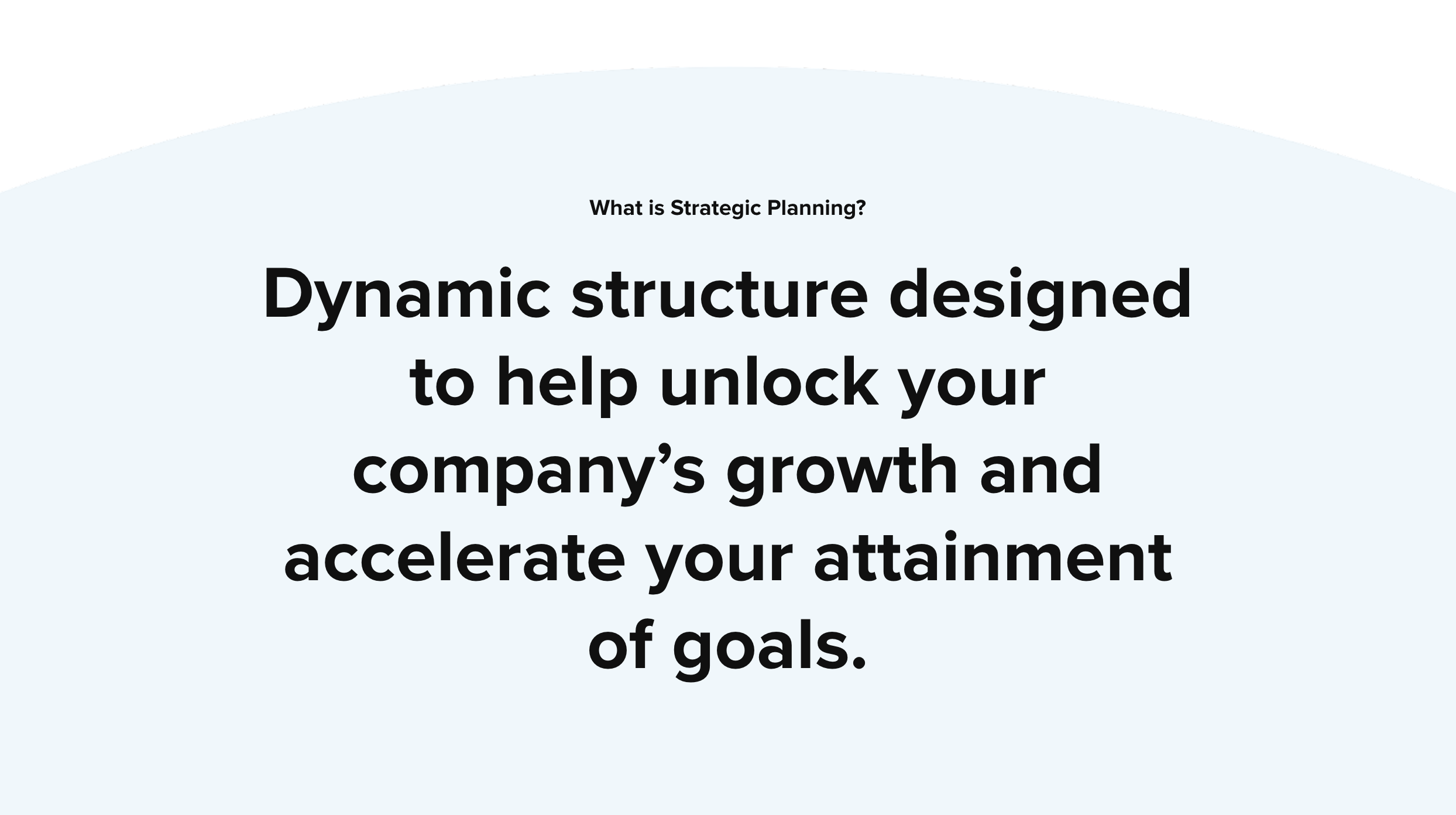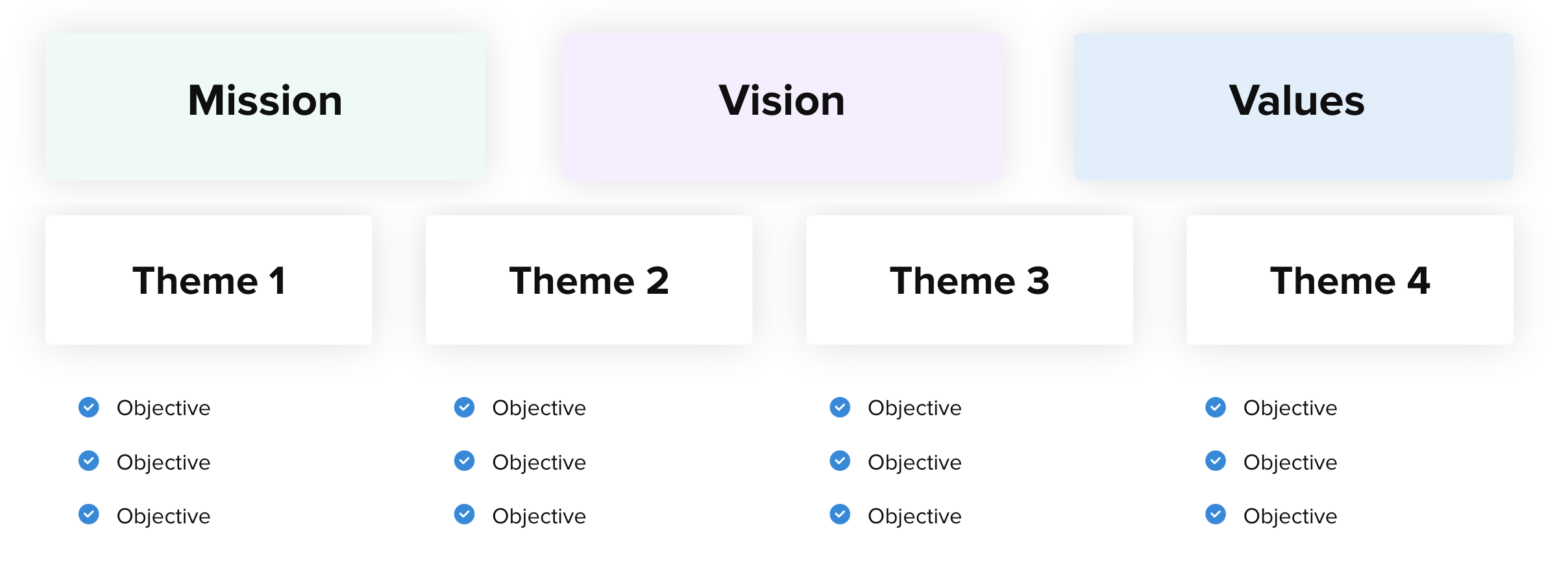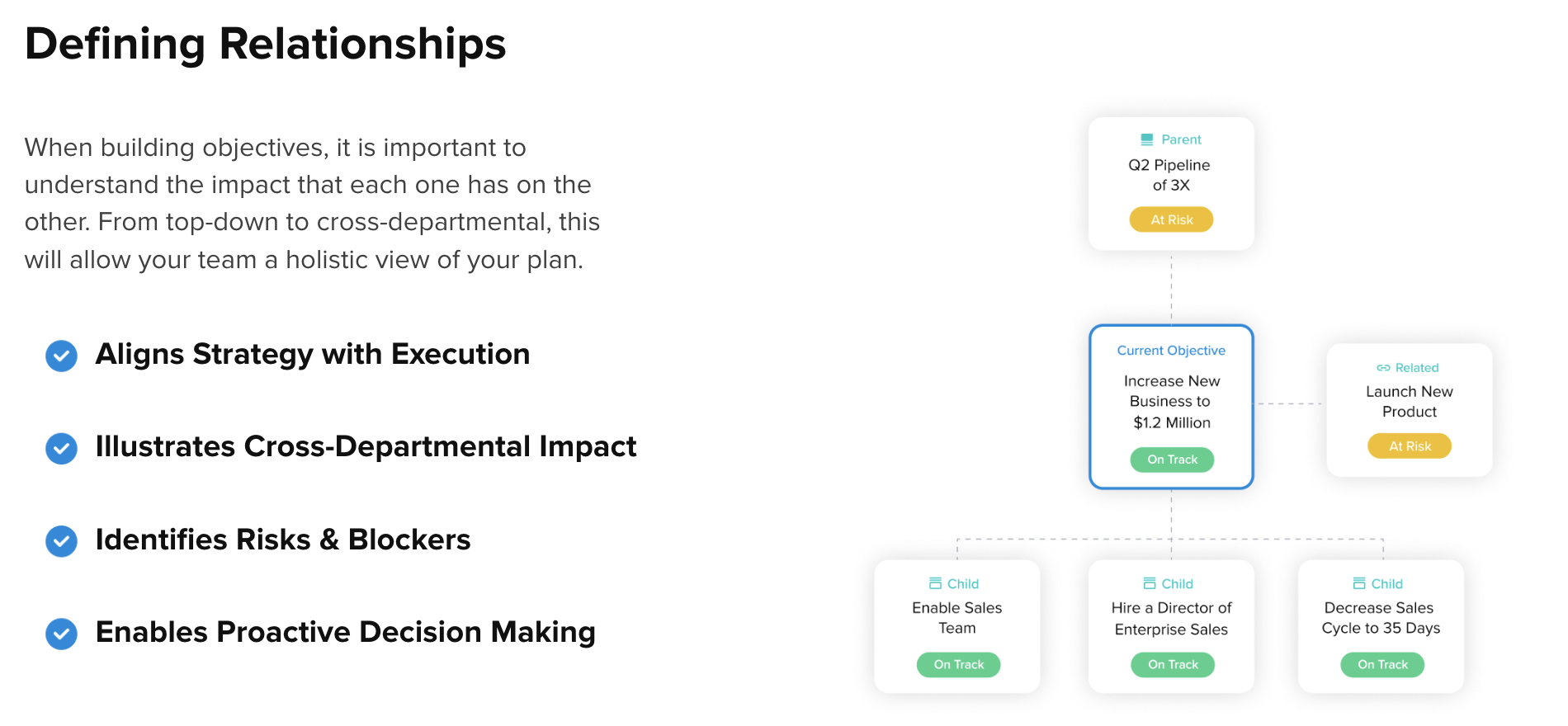
Today’s leading companies use Dynamic Planning to adapt to change, make better decisions, and move faster together.
For an overview how you can use Dynamic Planning to make execution a competitive advantage, check out our upcoming webinar 8 Ways to Amplify Your 2023 Strategic Plan.
For a comprehensive overview on how to Introduce Dynamic Planning to Your Company, we've written a 3 part series. Specifically, the articles included in this 3 part series are:
- Building the Case for Dynamic Planning
- Elevating from Traditional Planning to Dynamic Planning
- The Role of Strategy and Operations in Dynamic Planning (coming soon)
If you’d like to connect with our team to learn more about how Elate is partnering alongside leading Strategy and Operations teams to make the transition from Traditional Planning to Dynamic Planning, reach out to us today!
Traditional Strategic Planning is Broken
Unlike almost every other area of your business, Strategic Planning probably looks pretty similar today to how it did five years ago. It starts with an annual offsite to set direction and identify key initiatives for the coming year, followed by a company kickoff where the strategy is presented in PowerPoint slides to employees, and then revisited once a quarter, at best.
And the gap between where Strategic Planning is today for most companies and where it needs to go is only growing wider.
Over the past few months, we’ve seen a dramatic shift in the way companies are thinking about growth. Gone are the days where revenue could be bought at all costs, regardless of the return on your investment or inability to scale effectively. Today, Leaders are looking for ways to continue growing as capitally efficient and effectively as possible.
Enter Strategy and Operations Leaders.
More than any other part of the organization, Strategy and Operations Leaders often hold the keys to unlocking growth. We’ve seen a continued increase in the investment companies are making into Strategy and Operations teams, and don’t see that slowing down any time soon.
With capital efficiency and healthy growth top of mind for Executive Teams, the impact of Strategy and Operations Leaders to remove friction and turn execution into a competitive advantage has never been greater.
How Can We Fix Traditional Strategic Planning?
To effectively invoke change, Strategy and Operations Leaders must start by reevaluating the foundation for which the company is building their strategy upon, and the operating framework to support it moving forward. Unfortunately for most companies, current processes and structure doesn’t bode well for long-term success.

As we mentioned, there hasn’t been much change in how Strategic Planning looks today compared to five years ago. Sure, you might have tried introducing a Performance Management tool or OKR Warehouse to encourage employees to track updates, but these tools often go untouched until the end of a quarter.
Further, these tools provide little to no insight into actual company performance against your strategic plan. And rightfully so. They weren’t built as solutions to help unlock new opportunities for growth or to proactively identify risks that could impact your ability to execute your strategy.
From the current Strategic Planning processes to the tools available to Strategy and Operations Leaders, there is a significant gap between what exists today, and where the industry wants to go.
That’s where Elate is here to help. With a philosophy we refer to as Dynamic Planning, we believe Strategy and Operations Leaders can redefine the way companies execute their strategy to adapt to change, make better decisions, and move faster together.
Dynamic Planning is the Answer
In this three-part series, we highlight how companies can shift from a static, reactive approach for Strategic Planning to a framework that we call Dynamic Planning. Rather than the traditional Strategic Planning process that creates a disconnect between long-term vision and tactical execution, Dynamic Planning drives consistent behavior change across a company.
From how you build and evolve your Strategic Plan over the course of time, to the way in which your teams execute your plan at the highest level possible, Dynamic Planning can serve as a framework to unlock growth.
And shifting to a Dynamic Planning structure has never been more important. For evidence of the need to be more dynamic in your approach to planning, look no further than the current economic landscape. If we expect to navigate through ever changing market conditions, and make decisions proactively rather than reactively, a more dynamic approach to planning isn’t a nice to have. It’s a must-have.

However, bringing about change is always difficult, especially in a process like Strategic Planning that touches so many different parts of the business. So rather than just imposing a new way of Planning on team members, we want to begin by highlighting the case for why companies should make the shift to Dynamic Planning, and the impact it can have over time.
What Are the Benefits of Dynamic Planning?
In working with Strategy and Operations Leaders across the globe, we’ve seen three main areas of improvement you should expect in making the transition to Dynamic Planning:
- Drive Alignment + Adoption
- Move Faster
- Create Behavior Change

While any of these three values might be justified on their own, it’s important to understand that Dynamic Planning helps each of these areas build upon one another to ultimately create long-term behavior change. Rather than just seeing a short-term benefit of better collaboration across teams for a quarter, what we are truly aiming for with Dynamic Planning is to shift the culture of our organization.
But to do that, it starts with alignment and adoption.
Drive Alignment + Adoption
One of the parts that’s fascinating about Strategic Planning is that every company goes through this exercise. It’s one of the few processes in business that spans company size, industry, and vertical. However, the degree of impact and importance placed on the process varies from company to company.
For most companies, the process starts in a familiar place: the Executive Planning offsite.
Usually the executive offsite takes place once a year, and is the forum for where the discussion on long-term strategy begins, and unfortunately, often ends until the following year. We see this happen time and time again across companies who fall victim to simply going through the motions of Strategic Planning to check a box.
Far too often, Strategic Planning lives in a vacuum at the leadership level, and never makes its way to the rest of the company in a meaningful way. So instead of a catalyst for growth that carries momentum into the new year, this session often serves as the starting point where misalignment between leadership and team members begins in the traditional Planning process.
But that’s where Dynamic Planning > Traditional Planning.
One of the core components of Dynamic Planning is that it is a constant throughout the business. It’s the holistic lifecycle for how your company builds, executes, and reviews your strategy. This encompasses everything from the Executive Planning Offsite and Company Kickoff to the cadence your team’s put in place to review key initiatives.
Ultimately, Dynamic Planning provides the framework for how your organization aligns high-level strategy with tactical execution.

Building Blocks of a Dynamic Plan
While your company may refer to them as something different, any great Strategy and Operations Leader will have these three questions top of mind:
- What is our long-term direction? (3, 5, or 10-year horizon)
- What are we doing this year to help us get there, and what does a successful year look like? (one year horizon)
- How do we make that happen across teams? (Quarterly, Monthly, or Weekly horizon)
At Elate, we answer these questions with the following Building Blocks of a Dynamic Plan:
- Company Mission, Vision, Values: Not only do these help provide direction to employees, but they should help set the course for the long-term direction of the company. They provide the lens through which we evaluate priorities and decisions made yearly, quarterly, and daily.
- Company Themes: If your Mission, Vision, and Values set the long-term direction, Themes should be the bridge between tactical execution and strategic vision. Themes often serve as the annual rallying cries that serve as the foundation for how we set quarterly objectives, track monthly metrics, and prioritize initiatives that matter most to us as a business.
- Department, Team, and Individual Objectives: So how do we execute our plan and ensure team members understand how their work is connected to the company’s strategy and themes? Objectives. From Departments, Teams and Individuals, Objectives serve as the way to ensure we are driven by outcomes, not outputs.
- Establish Rituals: Create a cadence for how your team provides updates, how they review updates, and how they clearly communicate the outcome of Objectives.

Alignment starts at the top, but the operating framework you put in place drives long-term adoption. It’s important not to overlook the importance of setting a strong foundation for Dynamic Planning that can be built upon. As you’ll see, the more intentional you are in setting your foundation, the faster you’ll be able to move as a company.
Move Faster
An often overlooked aspect of the value in a holistic approach to Strategic Planning is the clarity it can provide to team members. Not only is Dynamic Planning a way to radically simplify how employees build their Objectives and connect them to overarching Company Themes, but it’s also a way to drive insights at the Leadership level. These insights help shift the Leadership Team and company to a more proactive approach to decision making.
In the traditional Planning process, once a plan is built, it may never leave the PowerPoint slides that were presented at the company kickoff. While some parts of the Strategic Plan might make it into an OKR Warehouse or Performance Management tool, the likelihood is that engagement and adoption is sorely lacking.
Employees don’t want yet another tool to punch the proverbial time card showing they did something this week. Instead, they want to understand how their efforts directly contribute to where the company is going, and how they can collaborate with other teams to ensure key initiatives are successful.
This can be seen firsthand in how well equipped a company is to pivot or aggressively pursue new opportunities that present themselves. As Christy Lynn White, Chief of Staff at Fullscript shares on Aspiring Ops, you should proactively communicate with team members and share, ‘Here’s what we’re doing and why’ because when change inevitably comes, team members have the necessary context to change with you.
If employees understand how their work is linked together, change is easier and communication is streamlined. This concept of connecting Objectives across teams in an easy, intuitive way is one of the core pillars of Dynamic Planning.
The process of connecting Objectives across teams in Dynamic Planning is what we refer to as Relationship Mapping. Not only does this take place vertically from leadership to individual contributors, but more importantly, it happens horizontally across departments. These Relationships can unlock a company's ability to proactively identify opportunities throughout the organization, or surface risks earlier than ever before.

Relationship mapping is a challenging part of the process for companies, especially for companies trying to build and track their Strategic Plan manually. It might seem straightforward to drop every team’s Objectives into a Google Sheet, but the reality is that there are no cross-department dependencies that can be added, insights that can be automated, or real-time data that can streamline decisions.
This proactive approach to identifying risks and opportunities through Relationship Mapping is the engine that powers Dynamic Planning.
While it might seem counterintuitive to spend time building out Relationships and connecting Objectives across teams, this is often the foundation of your framework that enables long-term success. As Ben Battaglia of Seismic shared in an episode of Aspiring Ops, “Slow is smooth, and smooth is fast.”
With greater visibility, alignment, and collaboration built into your framework, speed will be your greatest asset in turning your strategic planning process into a competitive advantage.
Create Behavior Change
Like every other part of your business, it’s the outcomes, not the outputs that matter.
For Sales Teams, success isn’t measured by the number of calls made, but the revenue generated. For Engineering, it’s not the amount of code shipped, but the quality and impact of features built. The same concept applies to every part of the organization.
When it comes to Strategy and Operations Leaders, it isn’t just about building a Strategic Plan and checking a box. It’s about building the best plan possible, mapping cross-functional relationships in that plan, and doing so well before Objectives have been rolled out and tracked by teams.
For Jordan Gift, Director of Strategic Initiatives at BeyondTrust, her and the team at BeyondTrust want to be on the leading edge of when initiatives are built. “Now, we’ve started to move the needle on being on the leading edge of initiatives,” shared Jordan. “People come to us now when they’re thinking about a project, objective, or initiative.”
Rather than the traditional process of setting a Strategic Plan at the leadership level, only to have it live in silos across the rest of the company, Dynamic Planning can bring an outcome-oriented plan to life in a way that drives true behavior change.
A few of the most common challenges we see across companies with Traditional Planning include:
- Misalignment on how Objectives are built, creating confusion and frustration for employees
- Difficulty communicating the ‘Why’ behind the Objectives that actually matter
- Lack of visibility into supporting Objectives, leading to missed targets and lack of execution
With Dynamic Planning and Elate, companies shift from putting out fires of urgent, non-essential Objectives to driving results for priorities that matter. We measure this in two ways: Employee Engagement and Objective Success Rate.

Just as you would expect your Sales Leader to be able to consistently refine how they build projections for their pipeline and accurately forecast revenue, the same can be done with Strategic Planning.
Dynamic Planning means building a sound plan that constantly evolves with the state of your business. It allows Strategy and Operations leaders to accurately forecast what needs to be done, understand how it will impact the company, and effectively communicate the direction to employees. As we referenced earlier, the more aligned you are across the business, the easier it will be to pivot or accelerate into new opportunities for growth.
However, driving behavior change isn’t easy, and as Toby Carrington, EVP of Global Operations at Seismic shares with us on Aspiring Ops, it often doesn’t come on the first attempt. Making the change can be hard, and it takes buy-in at the executive level and a commitment to seeing it through.
The Future of Planning is Dynamic
Building the case for transitioning from Traditional Planning to Dynamic Planning for your company’s Strategy is just the beginning. However, it’s a part of the process that can’t be skipped. It’s important to start by communicating the ‘why’ for your leadership team, and conveying the impact Dynamic Planning can have on your business, which is:
- Drive Alignment + Adoption
- Move Faster
- Create Behavior Change
But what happens once we’ve got buy-in? What is the role of the Strategy and Operations team in bringing Dynamic Planning to life? How does a company successfully make the transition from Traditional Strategic Planning to Dynamic Strategic Planning?
If you’re wondering, ‘What’s next?’, don’t worry, we’ve got you covered. Part Two of Elate’s series focuses on Elevating Your Strategy from Traditional Planning to Dynamic Planning, while Part Three is centered around The Role of Strategy and Operations Leaders in Dynamic Planning.
If you’d like to connect with our team to learn more about how Elate is partnering alongside leading Strategy and Operations teams to make the transition from Traditional Planning to Dynamic Planning, reach out to us today! We’d love to partner alongside you to Unlock Your Strategy.


